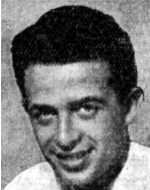Wexler, Meir-Morris (Miko)
Son of Bracha-Betty and Haim-Karol was born on May 17, 1924 in the city of Iasi, Romania. At the outbreak of the Second World War, his parents wanted to send him to England, but he did not want to remain in exile and decided to immigrate to Eretz Israel. At the Shalva high school in Tel Aviv, where he studied, he was an outstanding student, crowned with prizes. At the end of 1941, he joined the Palmach, and in 1942 he underwent a course for commanders in Beit Alpha and Mishmar Ha’emek, and in the Haganah, he practiced in the Dead Sea. After completing his studies, he was accepted to the university in Jerusalem and studied physics and chemistry in the department of Professor Farkash. He was a sharp and profound student, eager for Jewish studies and thirsty for general education. He has a wonderful perception. In 1947 he graduated with honors from the university and was awarded the title “Master”. He then began working in the university’s chemical lab and wanted to dedicate his life to science. In December 1947, after the UN General Assembly resolution on the partition of the country, he enlisted in the “Science Corps”. In his service there he merged his attachment to science and his national consciousness. He was a polite and gentle man whom Torah and the way of the country joined together. He found a free hour for everyone. He is a scientific worker and an active member of the Haganah, plays the violin and is active in sports. According to Moro’s testimony, he was to be a distinguished scientist. Meir immigrated with Hadassah’s convoy to Mount Scopus to complete his last attempts before moving to Tel Aviv. The road to Mount Scopus passed through the Arab neighborhood of Sheikh Jarrah and upon the outbreak of the war the movement was allowed to mount convoys secured by the British army. In the morning a convoy left Mount Scopus after the British promised that the road was open and safe. The convoy encountered an Arab ambush in the Sheikh Jarrah neighborhood and hundreds of Arabs hurled heavy gunfire at it. Some of the vehicles managed to get out and return, but two buses, an ambulance and a escort vehicle were ambushed. For many hours the convoy members fought and tried to prevent the Arabs from approaching the vehicles. Fire from our positions in the city and Mount Scopus, as well as armored vehicles sent to the area, failed to help the convoy. British military forces in the area did not intervene and did nothing to help, despite appeals to them. In the afternoon, the Arabs managed to set fire to two buses on their passengers, and only late in the evening did the Russians intervene and rescue the survivors from the trapped vehicles. He was brought to eternal rest in a mass grave in Sanhedria cemetery.
